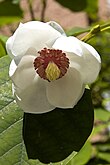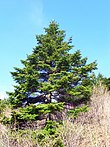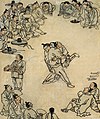 | |
| Emblem | |
|---|---|
| Anthem | "Aegukka" |
| Song | "Arirang" |
| Language | Korean |
| Currency | |
| Calendar | North Korean calendar |
| Living insignia | |
| Bird | |
| Flower | |
| Tree | |
| Inanimate insignia | |
| Color | |
| Costume | |
| Sport | |
 |
| Part of a series on the |
| Culture of Korea |
|---|
| Society |
| Arts and literature |
| Other |
| Symbols |
|
Upon its liberation in 1945 and subsequent foundation in 1948, North Korea adopted national symbols distinct from the national symbols of South Korea. The traditional flag of Korea, the Taegukgi, and the symbol Taeguk, were swapped for socialist symbols.
Some of the symbols of North Korea—the national emblem, flag, anthem and capital—are defined in the constitution of North Korea, while others such, as the national sport Ssirum or the national dish kimchi, are traditional. Some traditional symbols are shared with the South but with different connotations. Mount Paektu, for instance, is recognized as the symbol of Korea across the peninsula, but North Koreans revere it as the birthplace of Kim Jong Il. Some North Korean symbols are complemented with symbols for the ruling Kim family. For example, the Magnolia sieboldii is the national flower but the hybrid orchids Kimilsungia and Kimjongilia are also respected.







